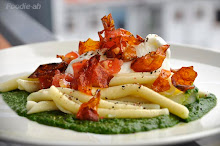Unfortunately I don't yet have wild fennel available here in Singapore, so I had to make do without it. I have ordered the seeds from Sicily, and I am planning to cultivate it myself in my herb garden. I will make this again when I will finally have one of the main ingredients. Said that, I can guarantee that this pasta tasted just as excellent without the wild fennel, despite missing one layer of flavour.
In order to add some colour to the pasta I replaced the wild fennel with Italian parsley, since that's what I had in the fridge. I bought the sardines frozen from Liang Court at S$12.80 for 6. A pretty good deal! The bucatini can also be purchased at Liang Court. All other ingredients are commonly available at any supermarket.
The complete list of ingredients is:
- 3 sardines
- 1 large red onion
- 1 anchovy
- a handful of breadcrumbs (I use Japanese 'panko')
- a couple of tablespoons of pine nuts
- a couple of tablespoons of raisins
- a pinch of saffron
- wild fennel (if you are in luck), or alternatively some fresh Italian parsley
Put the raisins in warm water and let them soften, the longer the better. Remove the heads and tails from the sardines, split them into 2 lengthwise and remove the innards. Carefully extract the spine and as many of the little bones as you can. Put the heads and bones into a small skillet, quickly fry them in olive oil and top them with a glass of water. Bring to the boil, then simmer over low heat (if you happened to have some fennel, I think a few chunks of it would hugely benefit this quiuck stock!). Wash the sardines, sprinkle them with salt and set them aside.
Bring a large frying pan to medium heat, then pour the fresh pine nuts onto it. Gently keep shaking the pan, rolling the pine nuts until they are nice and golden on both sides. Put them back into a small bowl. Repeat the same operation with a handful of 'panko' (breadcrumbs), until from yellow they turn light brown and crispy. Remove from the pan and set aside.
Pour generous olive oil into the same pan, and fry the sardines skin side down first for a minute over medium heat, then turn them to the other side and cook for another 30 seconds. Remove from the hot pan with a large spatula, paying attention not to break them. It is in fact important that your pan is not a non-stick one (as pictured, a solid metal pan is the best choice). Raise the heat to high, then deglaze with a splash of white wine. The reaction should create a cloudy, creamy sauce.
Reduce the heat to medium, pour in the finely chopped onion and keep stirring until it slowly browns. In the meantime, bring a large pot of water to the boil for the bucatini. When the onions are nicely golden and reduced, dissolve a pinch of saffron and the anchovy into half a glass of the boiling water, then pour into the frying pan together with the onions. Also add the raisins, the pine nuts and the whole parsley stems, unchopped.
Salt the boiling water and add the bucatini. Put some of the sardines into the pan which should now be on low heat and reserve a couple of them for decoration. In the meantime, strain the stock which you have been simmering on the side with a fine sieve, and gradually add it into the pan as more juices are needed.
When the bucatini are ready (follow the directions on the packaging), drain them and put them into the sauce pan. Mix well, then top up with some toasted breadcrumbs and freshly ground black pepper. Make sure that there is enough juice in the pan when you add the bucatini (see pictures), and add either some of the stock or some of the bucatini cooking water to maintain the right level of juiciness.
Place a portion of bucatini on each plate, then top with some of the onions sauce, juices, decorate with 1-2 sardines and sprinkle with additional breadcrumbs and pepper.
I had this pasta at Gattopardo, and really liked it. I must say I enjoyed mine just as much despite the missing finocchietto, but hopefully I will be able to grow that successfully.















2 comments:
you make cooking look so effortless.
your dishes always look delicious. well done! :)
Thanks, that's a great compliment! I wish somebody tried it and found that it is as easy as I described it.
Post a Comment